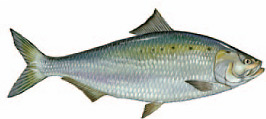 Scientific Name
Scientific Name
Alosa sapidissima
Other Common Names
white shad
Identification
Largest of the river herring Family, American shad average around 3 lbs., with fish up to 5 lbs. common. Silver-sided with greenish-blue back; deep bodied from the side, narrow and symmetrical top to bottom head-on; row of dark spots on the sides, running back from the gill cover; the upper and lower jaws are equal length when the mouth is closed.
Best Fishing
Rivers: James (Richmond fall line area), Mattaponi, Pamunkey. (It is now illegal for any person to have river herring in their possession, including blueback herring and alewife. For more information about this regulation, see the VMRC website.)
Fishing Techniques
Best time from mid-March to early May in fall line areas of tidal rivers as adults return to spawn. Light spincasting rods and reels, with 1/32 to 1/8 oz., brightly colored shad darts, spoons, jigs, or small minnow imitation lures. Fly fishing with darts, gold or white soft-bodied streamers, and other wet flies. Increased success in deeper water; do not usually jump but give a good fight; need to be carefully played to avoid tearing delicate mouth. (Check current regulations for restrictions and limits.)
Feeding Habits
Young shad in fresh and tidal portions of rivers feed on zooplankton (microscopic animals) and insect larvae; Adult shad in the ocean eat primarily zooplankton (microscopic animals), but can take worms or small fish. During spawning runs, adults eat very little, if anything.
Habitat
American shad are anadromous; as adults they travel in large schools along ocean coastal areas for 4 or 5 years, until they are sexually mature, and then run up large rivers from saltwater to freshwater to spawn. After spawning, surviving adults return to the ocean. Newly hatched young remain in freshwater until fall; in the fall, they move downstream to brackish estuaries where they may remain for a year or more before moving out to the ocean.
Spawning Habits
Shad run up rivers in the spring as water temperatures reach the mid-50F mark. Males usually come upstream first, with spawning occurring over sandbars or rocky riffles at dusk and into the night in an average depth of 6ft. of water; peak spawning is at about 65F. Shad eggs are neutrally buoyant, floating suspended in open water until they hatch in about 4 to 12 days.


